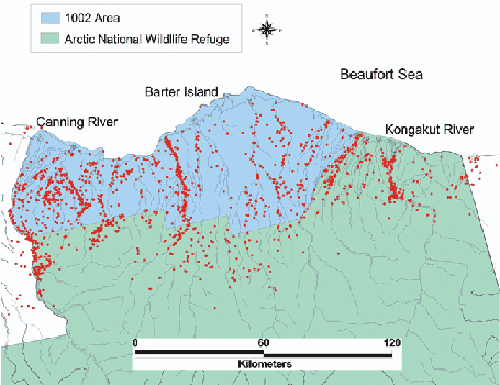
| Home
Mission 2007 Team Members Research Sources Progress Journal |
| What Are the Impacts
of Oil Exploration and Drilling on ANWR Primary-Level Consumers? Primary-level consumers in ANWR include several species of mammals, as well as many different insects. However, the insect population of the area has not been studied very extensively, and it is doubtful that oil exploration can be detrimental to their survival. Mosquitos and Oestrid flies are abundant during the summer and are a major nuisance to individuals in the porcupine caribou herd. The result is that the animals' foraging time is reduced as they spend more time avoiding the flies, which decreases their chances of surviving the winter. Lactating females are especially effected. The author believes that the insect population will actually increase if human activities begin in the area, due to the generation of trash and the decomposition of individuals of other species negatively affected by this human presence. Since little is actually known about the insects of the area, we shall concern ourselves mostly with the herbivorous mammals of the area, the most prominent of which is the muskoxen. Other mammals include various species of voles and lemmings. See: http://www.absc.usgs.gov/1002/section3part3.htm Muskoxen Muskoxen (Ovibos moschatus) were driven to extinction before the 20th century. They were reintroduced in 1969 and their numbers reached a peak at almost 400 individuals in 1986. Since then, the muskoxen population has declined to around 200 individuals. Reasons for this population decline include emigration, increased predation by grizzly bears, and severe winters. Also, hunting by humans has increased since their reintroduction.  Picture taken from http://www.absc.usgs.gov/1002/images/Fig07-01.gif. Muskoxen conserve energy by limiting their movement; they tend to stick to a core area about 50 km2 in the winter and 200 km2 during the calving and summer seasons. Calving occurs from March to June, so it is especially important for mothers to build up enough reserves during the summer to last the winter and to feed the newborn. Thus, a prolonged winter would have significant negative impacts on calf survival. Muskoxen depend on riparian cover along river corridors, floodplains, and foothills year-round. During the winter, it seeks out areas of soft shallow snow. Its winter diet consists mainly of low-quality forage such as sedges, grasses, mosses, and forbs. In the spring, it feeds on high quality flowering sedges. Muskoxen tend to be very loyal to a particular spot, returning there year after year.  Muskoxen herd Any human activity should stay away from the muskoxen habitats, including adjacent uplands. The areas that muskoxen frequent are places often used for gravel and water extraction for roads and/or platforms. Muskoxen congregate into larger groups in the winter, and large groups of animals are more likely to be disturbed by human activity because they tend to have more sensitive individuals. Muskoxen groups that have moved west tolerate the Trans-Alaskan pipeline and the Dalton highway, but it is due to the wider area of habitable land available to the animals. Muskoxen remaining in the 1002 coastal plain are in a more geographically constricted habitat, with the Beaufort Sea to the north and the Brooks Range to the south. Eastern muskoxen populations are likely to suffer if human activities displace their territories and there are few alternative habitats available.  Range expansion of muskoxen in mixed-sex groups in and near the Arctic National Wildlife Refuge, Alaska, 1969-1993. Total ranges were defined by 95% adaptive kernel contours. Core areas were defined by 70% adaptive kernel contours. From http://www.absc.usgs.gov/1002/section7part1.htm As muskoxen populations in the far west have coexisted peacefully with the Trans-Alaskan pipeline, a similar pipeline through the 1002 region should have little impact as well-- if it is built with the same environmental precautions. For example, the Trans-Alaskan pipeline has 579 animal crossings over its 800 mile span. Helicopters and low-flying aircraft have been noted to cause some herds to stampede and abandon their calves. Some herds have been agitated by 3-D seismic exploration as far as three kilometers away; other herds seem unperturbed as close as 300 m. Generally, noise produced by traffic, etc will have a negative effect on the animals. Little data are available on the interaction between muskoxen and human settlement associated with oil development. This is because drilling platforms have been built in regions rarely visited by muskoxen. However, the nature of the muskoxen's normal food source is such that its scavenging among human waste is unlikely. The major concern is the gravel used for the platforms, which would have to be extracted from muskoxen habitats.  Locations of mixed-sex groups of muskoxen seen during winter and summer surveys in the Arctic National Wildlife Refuge, Alaska, USA, 1982-1999. Pictures taken from http://www.absc.usgs.gov/1002/images/Fig07-06.gif, http://www.saskschools.ca/~gregory/arctic/animals/mox.jpg.  See: Section 7, Arctic Refuge Coastal Plane Terrestrial Wildlife Research Summaries http://www.absc.usgs.gov/1002/section7part1.htm http://www.absc.usgs.gov/1002/section7part2.htm http://books.nap.edu/books/0309087376/html/117.html http://www.jpo.doi.gov/pthom/Environmental%20Report.pdf Oil or Animals report Lemmings and Voles Lemmings and Voles tend to be more abundant and have less survival issues than muskoxen. In the winter they live in large underground burrows that may be as close as two inches from the permafrost. There are two species of lemmings in the area: the brown lemming (Lemmus sibiricus) and the collared lemming (Dicrostonyx groenlandicus). The brown lemming prefers wetter environments like damp meadows and river or lake shores, while the collared lemming prefers rockier places. Lemmings live on plants, roots, berries, and lichens, and stored seeds in the winter.  A lemming; picture located here. There are two species of voles in the 1002 area: the northern red-backed vole (Clethrionomys rutilus) and the singing vole (Microtus miurus) . The northern red-backed vole feeds on leaves, buds, and twigs. They are active all winter, making the most of their short lives: by the end of the summer, all those born before the last year have died. The signing vole is known for its alarm call, a high pitched trill. Singing voles are colonial, behaving much like prarie dogs. They feed on stored tubers during the long winter season. Burrows of singing voles are often raided by native peoples, who pilfer the stored tubers for their own use. Because of their numbers lemmings and voles are not likely to be wiped out by human activity in the region. However, they are an important source of food for higher lever consumers, including polar bears, wolves, and foxes. Lemming cycles-- population booms and busts every four to five years-- for example, are closely tied to the population cycles of various predators. A sharp drop in their numbers could potentially cause a population decrease in many other, higher-level consumers. Read: The National Audubon Society Field Guide to North American Mammals by John Whitaker Jr. www.arctic.uoguelph.ca/cpl/organisms/mammals/Terrestrial/brownlem.htm www.saskschools.ca/~gregory/arctic/Awildlife.html McGill University on northern red-backed voles animal.discovery.com/guides/mammals/habitat/northforest/northvole.html www.arctic.uoguelph.ca/cpl/organisms/mammals/Terrestrial/singingvole.htm By Ross Fu |



| Last updated: Nov 26, 2003 (12am) | Webmistresses: Holly and Lia Team 7 - m2007-7@mit.edu |